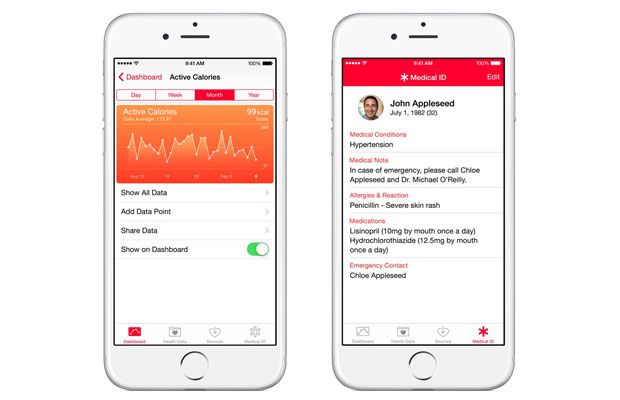Attention Apple-lovers and stat-tracking fanatics: Apple unveiled the long-awaited iPhone 6 today, and with it comes a new app called Health, which marks the company’s first foray into gathering and organizing your health data.
Health will allow you to input basic information like birth date, will record certain data on its own, and can collect statistics from third-party fitness devices and apps like Nike+ including footsteps, heart rate, and sleep activity. (And yes, you can control which of your apps sync with Health.)
The iPhone 6 will be available on September 19, but you don't need to buy a new phone to try the app. The new devices run on the revamped iOS 8 operating system, which will also be available for download on older devices on Wednesday, September 17.
Here, the coolest features in the new app:
Health data at a glance
The app’s Dashboard presents your essential data as cards that you can flip through to view at a glance. All told, the Health app sorts and organizes your health information (whether collected internally or via a supported app or device) across categories including fitness, nutrition, lab results, medications, sleep, and vitals. This streamlines your flow of health and fitness data and, most importantly, helps you make sense of it all.
Emergency contact cards
The Medical ID feature allows you to store critical information—say, blood type or food allergies—to create an emergency card that’s accessible from your device’s Lock screen. First responders or good Samaritans will be able to call the emergency contacts listed in Medical ID.
Built-in step counter
The Health app can access your device’s motion processor (available in the iPhone 5s, iPad Air, and the iPad mini with Retina display and in the new iPhone 6 and 6 Plus), which enables the device to measure steps taken (and whether you're walking or running) all on its own—no fitness tracker necessary. The Steps section of the app then tallies the number of steps you take, allowing you to sort by day, week, month, or year. Plus, you can view your log in terms of the number of steps taken or as actual distance travelled, and Steps data can also be shared with other apps.
Tracking for coffee junkies
The app’s Nutrition section features a Caffeine tab to help you track how much you consume from a variety of sources (coffee, tea, soda, and more). You'll have to enter it manually unless you use third-party apps like UP Coffee from Jawbone, which can help you understand how caffeine influences your sleep and other aspects of your life.
Patient-doctor connectivity
Thanks to a partnership Apple forged with the Mayo Clinic, people who see Mayo doctors are even more connected. The Health app could flag users if blood pressure or heart rate falls outside of normal levels (third party apps would have to be synced to measure those). In that case, a doctor can contact you with follow-up information and recommendations for treatment. Apple hopes to bring this functionality to healthcare systems across the country including Mount Sinai, Johns Hopkins, and Cleveland Clinic, Reuters reports.
Smarter apps that could self-adjust
Imagine your nutrition app telling your fitness app how many calories you ate yesterday and adjusting your workouts for the rest of the week. With HealthKit, it could become a reality. HealthKit lets the app draw data from multiple sources and compile it in one central location, while allowing all your other health and fitness apps to work together. Fitness app developers are sure to release updated versions that are compatible with the new operating system, Yahoo Tech reports.
Possible lung function tracking
The Health app also supports tracking for spirometry, a measure of how much air you inhale and exhale and the rate at which you breathe (this is key for people with asthma or COPD). Your device can't track breathing on its own, but this feature may enable doctors to use more sophisticated medical tools to track respiratory health and diagnose lung conditions.
